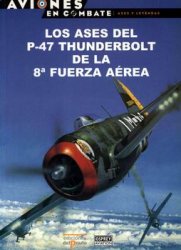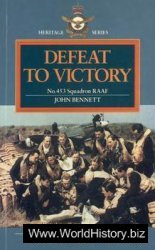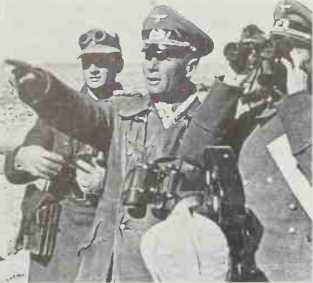
Rommel directs operations, N Africa
He occupied Northern Italy when the Badoglio government capitulated in September 1943; and three months later was made responsible for the defence of the Channel coast in anticipation of the Allied invasion of Western Europe. He advocated a policy of forward defence because his experience in Africa persuaded him that it would be impracticable to move armoured formations in daylight under conditions of Allied air supremacy. Von Rundstedt and Gude-rian took the contrary view. In the event, the German panzer formations were committed piecemeal, and failed to destroy the Allies’ beachhead in June 1944.
By the beginning of July, Rommel and von Rundstedt were trying to persuade Hitler to withdraw to the Seine. Rommel was seriously injured on July 15 when his car was attacked by Allied fighters just two days before the abortive attempt on Hitler’s life. Implicated in the plot, he was forced to take his own life on October 14 1944. WGFJ.
Roosevelt, Eleanor (1884-1962). US. Wife of President F D Roosevelt; made morale-boosting visits to Britain (1942) and the Southwest Pacific (1943).
Roosevelt, Franklin Delano
(1882-1945). US President, 193345. Assistant Secretary of the Navy, 1913-20; retired from public life, 1921-28, when stricken with poliomyelitis. Following landslide victory in Presidential election, 1932, implemented “New Deal” domestic policies; foreign policy increasingly influenced by Japanese expansion in Asia and, in 1939, outbreak of World War II.
Although restrained by the significant US isolationist lobby, Roosevelt gradually expanded American armed forces and, in
1940, adopted an increasingly helpful stance towards Britain. Anglo-American staff talks took place, the Lend-Lease Act was passed in May 1941, and in August 1941 Roosevelt and Churchill produced the Atlantic Charter. With America’s entry into the war, Roosevelt, in spite of his physical disability, played a major part in the Allied conferences at Casablanca, Quebec, Cairo, Tehran and Yalta. He agreed to make the defeat of Germany the Allied priority, but opposed British proposals for Mediterranean and Balkan operations at the expense of an early cross-Channel invasion. Distrusting European, and particularly British, “colonialism”, he yet proved more sanguine than Churchill regarding Soviet intentions in eastern Europe. He died on April 12 1945; succeeded as President by Harry S Truman. MS.
Root, Elihu (1845-1937). US Secretary of War, 1899-1904, initiating reforms similar to those of Haldane in Britain. His achievements included establishment of the Army War College in 1901 and creation, in 1903, of an efficient Army General Staff of the European model. As well as reforming the high command, he reorganized the reserve structure and encouraged weapons development programmes. Secretary of State under Theodore Roosevelt in 1905-09.
Rostov, Battle of (1941). In spite of the Red Army’s staggering losses during the first months of the German invasion, on November 9
1941, Marshal Timoshenko, commander Southwestern Front, proposed a counteroffensive on his southern flank near Rostov. Ironically his attack on November 17 precisely coincided with a German offensive launched by von Kleist’s First Panzer Army aimed not only at Rostov itself but also at access to the oilfields of the Caucasus and the Soviet supply route from Iran. On November 20 Rostov fell to von Mackensen’s III Panzer Corps, but on the 27th, men of the 33rd Motorized Rifle Regiment of Gen Remezov’s Fiftysixth Army attacked across the frozen River Don and seized a bridgehead in the city. They were supported by two battalions of the Rostov militia who were joined by units of Gen Kharitonov’s Ninth Army. Fearing encirclement, the German forces hastily abandoned the city and, by November 29, Soviet forces had reoccupied it. The German Army had thus sustained its first major reverse in operations against the Soviet Union. Furthermore, this setback on the southern flank resulted in the dispatch of reinforcements to the sector at the cost of weakening the central thrust against Moscow. MS.
Rostow, Walt W (b. l916). US. Adviser in the Kennedy and Johnson administrations. As chair of the State Department’s Policy Planning Council and later as National Security Adviser, he advanced the “Rostow thesis”. This held that externally supported insurgencies could be defeated only if military action terminated the support at its source. The “thesis” was influential in shaping American policy in the Vietnam War.
Rosyth, Firth of Forth, Scotland. World-War-I base of British battle cruisers; until 1938 intended Home Fleet base for war with Germany. Used thus, early World War II, while Scapa Flow defences were strengthened.
Rotterdam, bombing of (May 14 1940). The Luftwaffe planned to attack a number of Dutch centres of military resistance to the German capture of Rotterdam. The bombing was to start at 1500 hours. At 1415 hours a signal was received at Luftflotte 2 hq from the Germans in Rotterdam that the attack was to be postponed while negotiations for surrender proceeded. Already, however, 100 Heinkel He Ills of KG 54 led by Col Lackner were on their way to the target and they received no signal. Nor at first did they recognize red Very lights fired from the ground as instructions not to attack. At the last moment, about 40 bombers turned away but the remainder unloaded about 100 tons of HE bombs on the targets. Widespread damage was caused, mostly by fires that the Dutch were ill-equipped to control, and about 900 people were killed. ANF.
Rouen-Sotteville. French marshalling yards, the target of the US Eighth Air Force’s first bombing mission, August 17 1942.
Royal Air Force (RAF). Formed on the basis of the Royal Naval Air Service and the Royal Flying Corps on April 1 1918. It was the world’s first independent fighting air service.
Royal Armoured Corps (RAC), British Army. Formed shortly before World War II to rationalize manning and training of Royal Tank Regiment and of horsed cavalry regiments undergoing mechanization. US Army equivalent: Cavalry and Armor.
Royal Army Medical Corps (RAMC), British Army. Formed in 1898 to replace earlier (and often haphazard) systems of medical support in peace and war. Equivalents to be found in all armies.
Royal Army Ordnance Corps (RAOC), British Army. Historical roots in 15th century, when its hq was in the Tower of London. Now responsible for Army’s provisioning, including fuels and ammunition as well as all warlike and general stores.
Royal Army Service Corps (RASC), British Army. Responsible for supplies and transport and many ancillary tasks until rationalization of 1950s, when RAOC assumed task of supplying fuel, rations and ammunition. Transportation roles passed to new Royal Corps of Transport.
Royal Artillery (RA), British Army. Responsible for all types of indirect gun and missile fire support for the army. Organized in Regiments and Batteries. In US and most other armies, in battalions and companies.
Royal Corps of Signals, British Army. Evolved from branch of Royal Engineers which pioneered radio telephony in Army. US Army equivalent: Signal Corps.
Royal Corps of Transport (RCT).
British Army. Assumed rasc and RE transportation roles in 1959. US equivalent is the Transportation Corps.
Royal Electrical and Mechanical Engineers (REME). British Army. Formed 1942 to rationalize field and base repairs of all types of military equipment.
Royal Engineers (RE). British Army. Supporting combat arm responsible for field and general engineering works, including bridges, airfield construction, demolitions, large-scale minelaying and minefield breaching.
Royal Flying Corps (RFC).
Formed on the basis of the Air Battalion of the Royal Engineers on May 13 1912. It consisted of the Military Wing, administered by the War Office, the Naval Wing, administered by the Admiralty, and the Central Fljdng School, for which the responsibility was shared by the two departments. Its mechanical requirements were supplied by the Royal Aircraft Factory. The assumption that, although military and naval operational requirements would differ, the common interest of having an adequate supply of efficient flying men would best be met by a single force, failed to meet the conflicting views of the War Office and Admiralty. On the eve of the outbreak of war in 1914, the Naval Wing was rechristened the Royal Naval Air Service (rnas) and the Military Wing assumed the title of the Royal Flying Corps. Thereafter, the RFC was predominantly engaged in the direct support of the Army in the field by reconnaissance and then bombing. Although increasing ranges led to some attempts at strategic bombing, this was a role in which the rnas showed the greater interest. In
1917 Smuts recommended that the RFC and RNAS should be merged to form a new independent fighting service exclusively concerned v/ith the air. This was done on April 1
1918 when the Royal Air Force came into being. ANF.
Royal Marines (RM). Britain’s sea-soldiers. Their duties involved manning ships’ guns and supplying landing forces. Having provided some commandos before 1945, they then took over the commando role entirely.
Royal Naval Air Service (RNAS)
See ROYAL FLYING CORPS.
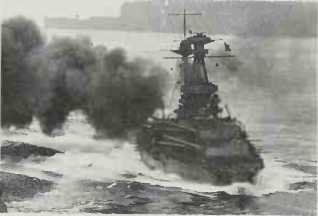
HMS Roya/ Oak fires a broadside
Royal Oak, British battleship, torpedoed and sunk (833 dead) while at anchor in Scapa Flow by U-47 (Lt Commander Gunther Prien), night of October 13-14 1939.
Royal Sovereign. British ‘R’-class battleship, completed in 1916. She served in the Atlantic and with the Eastern Fleet in World War II before being transferred to the Russian Navy as the Archangelsk, 1944-49.
Royal Tank Regiment (RTR), British Army. Formerly Royal Tank Corps, formed 1923 specifically to man tanks and armoured cars. Became part of Royal Armoured Corps when cavalry mechanized.
Rozhdestvenski, Rear Adm Zino-vi Petrovich (1848-1909). Russian. Few commanders have had a more difficult task than Rozhdestvenski, who, in 1904, was ordered to take the Russian Baltic Fleet to the Far East. His seamanship has been criticized, but it says much for his determination and organizational ability that he was able to shepherd some 45 ships of widely differing qualities in a 7-month voyage across 20,000 miles (32,000km) of oceans in which few bases were available for refuelling or repair. Tactical indecision contributed to his crushing defeat at Tsushima, but in a postwar court martial he was cleared of blame, having been severely wounded and unconscious when his deputy, Adm Nebogatov, surrendered. RO’N.
Rudnik Ridges, Battle of the see
SERBIAN CAMPAIGN.
Ruge, Maj Gen Otto (1882-1961). Norwegian, c-in-c Norwegian Army, Norwegian campaign, 1940.
Ruhr, Battle of. British night bombing of Germany, March 5-
July 13 1943, when the Ruhr, and within it Essen, against which 2,070 sorties were dispatched in five major attacks, was the primary target. Other Ruhr towns heavily bombed included Duisburg, Krefeld, Diisseldorf, Dortmund, Gelsenkirchen, Wuppertal and Bochum. Numerous heavy attacks were also made on towns far beyond the Ruhr, including Berlin, Pilsen, Nuremberg, Munich and Frankfurt am Main, to keep the German defences spread. In all there were 43 major actions involving the dispatch of 18,506 sorties. A total of 872 bombers failed to return and 2,126 were damaged, some beyond repair and with the loss of their crews. The daily available strength of Bomber Command during the Battle varied from 593 to 787 aircraft with crews. The Battle was the first major test of heavy night attack led by the Pathfinder Force with the aid of Oboe and H2S. Oboe, which reached to the Ruhr but not much beyond it, proved to be more accurate than anything previously tried, and, by comparison, H2S was disappointing. For the first time in the war Bomber Command succeeded in inflicting major damage on the Ruhr towns. Goebbels and Speer, who were responsible respectively for morale and war production; both expressed anxiety because, although the German air defences destroyed more than the equivalent of the front line with which Bomber Command began the action, they failed, for the first time in the war, to prevent the constant repetition of severely devastating attacks. ANF.
Ruhr Pocket, Battle of (1945). The Ruhr, Germany’s primary industrial centre, was a major objective for the Allied armies after their breakout from Normandy. Montgomery’s attempt to make a rapid thrust into it had failed at Arnhem and it was not until the Allied armies had made crossings of the Rhine in March 1945 that the opportunity of an encirclement offered. In the south, VII Corps of First US Army pushed out of its bridgehead at Remagen with the 3rd Armoured Division’s tanks speeding through the defences of Model’s Army Group B. Meanwhile in the north. Ninth US
Army’s 2nd Armoured Division pressed forward and on April 1 the US forces linked up at Lippstadt and the encirclement was complete. The Ruhr pocket was systematically reduced until, on April 17, all resistance was at an end and over 300,000 of its defenders taken prisoner. Model, judging himself disgraced, committed suicide on April 21. MS.
Rumpler C VII (German, WWI). Two-seat long-range reconnaissance. Late-1917 development of Rumpler C IV; both types noted for exceptional high-altitude performance. Almost identical Rubild (Rumpler C VI) photographic-reconnaissance type could operate at heights virtually unattainable by Allied fighters. One 240hp Maybach Mb IV engine; max. speed 109mph (174kph); two 7.9mm machine guns.
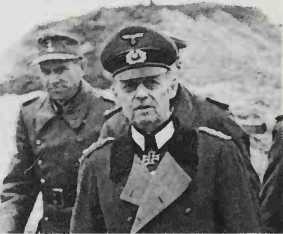
Field Marshal von Rundstedt
Rundstedt, Field Marshal Gerd
Von (1875-1953). Ger. During World War I, Rundstedt served on both the Eastern and Western fronts in staff and frontline posts. He remained in the army throughout the interwar years, developing a somewhat ambivalent attitude towards the Nazis. He approved of their strengthening of the armed forces but was openly critical of their ruthless treatment of his contemporaries, von Blomberg and von Fritsch. In 1938 he retired, but with the invasion of Poland returned to active service, helping prepare the attack and commanding Army Group South during the campaign. In 1940 his. Army Group A delivered the unexpected blow in the Ardennes that turned the Battle of France; he was promoted Field Marshal in July 1940 and in 1941 was made c-in-c. Army Group South for “Barbaros-sa”. Although doubting the wisdom of the attack, Rundstedt managed to get the best out of a multinational force including Germans, Hungarians, Slovakians, Italians and Romanians. However, by winter he needed to withdraw some of his units but was refused permission by Hitler and relieved of his command on December 1
1941. In March 1942 he was appointed c-in-c. West with the task of securing Western Europe against Allied invasion. His clash with Rommel, his younger subordinate, over defensive strategy contributed to the poorly coordinated response to “Overlord”. Rundstedt was once again relieved of his command, but was quickly recalled as c-in-c. West. Nominally he led the Ardennes offensive of December 1944, but although it was known at the time as the “Rundstedt offensive”, it was Hitler’s scheme and von Rundstedt had little faith in its success. The vindication of his doubts did not prevent him from a further dismissal and he held no further command. MS.
Rung Sat Special Zone. The Rung Sat, or “Forest of Assassins”, straddles the narrow Long Tau river passage connecting Saigon with the South China Sea. During the Vietnam War, a communist sapper group based just north of the Rung Sat used its dense, mangrove swamp to plant mines and harass shipping in the channel. The Special Zone comprising this swamp was part of the Army of the Republic (arvn) III Corps Tactical Zone. The US Navy, Marines and Army launched amphibious attacks into this stronghold beginning with Operation “Jackstay” in March-April 1966. By means of river patrols, minesweeping, hunts on land and drastic defoliation, US, South Vietnamese, Australian and Thai forces substantially cleared the zone, although sappers periodically returned to fire on ships in transit. WST.
Rupertus, Maj Gen William H
(1889-1945). US. The Assistant Divisional Commander of the US 1st Marine Division in the Guadal-canal-Tulagi operations of 1942, Rupertus took overall command of the formation the following July, leading it in the assault on Cape Gloucester in December 1943 and on Peleliu in September 1944.




 World History
World History



